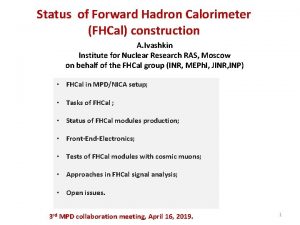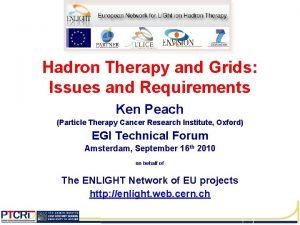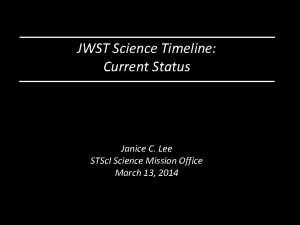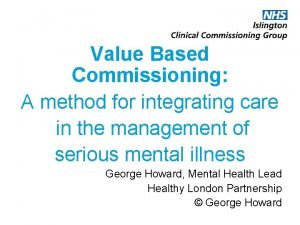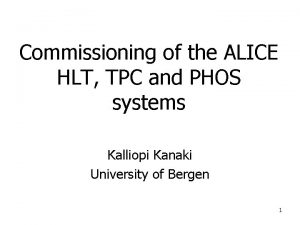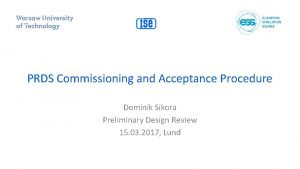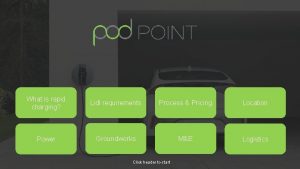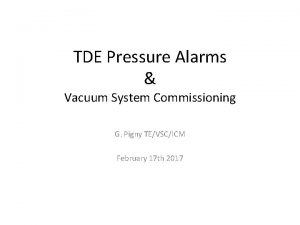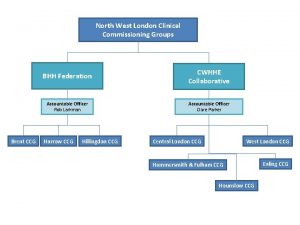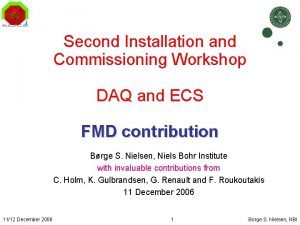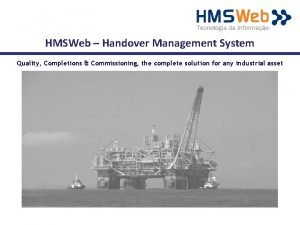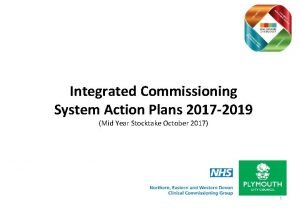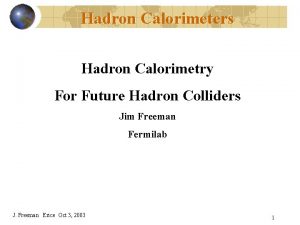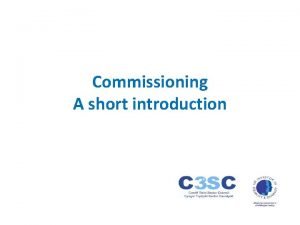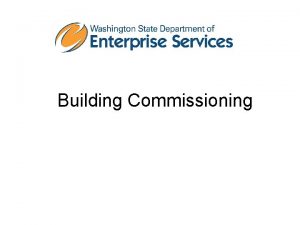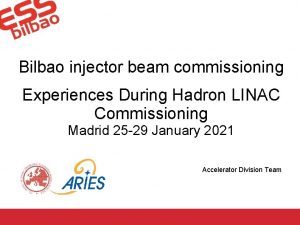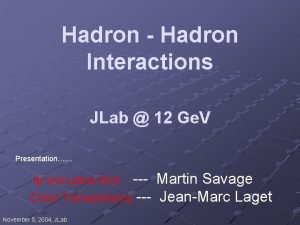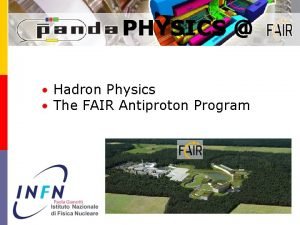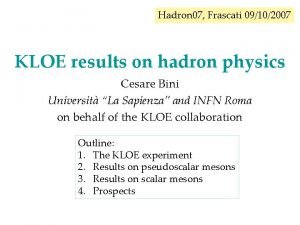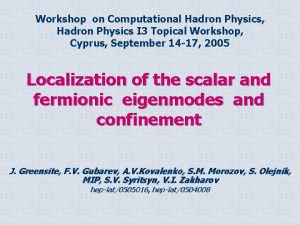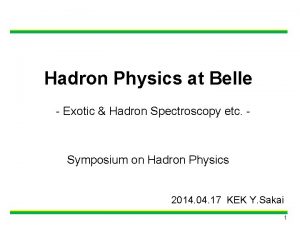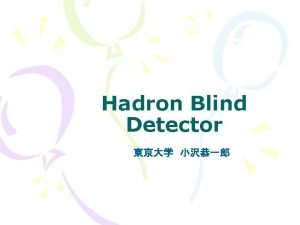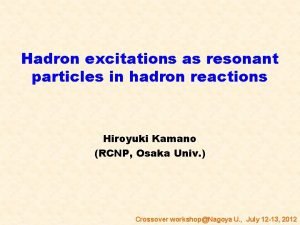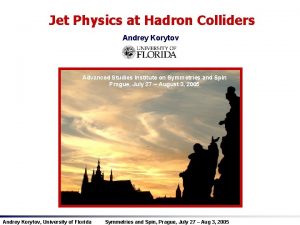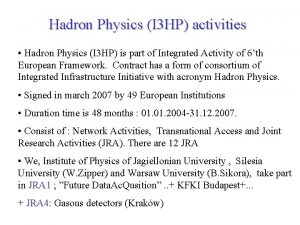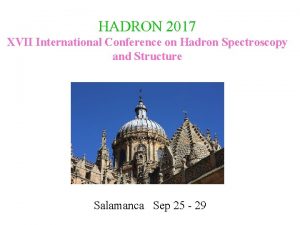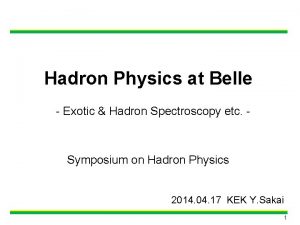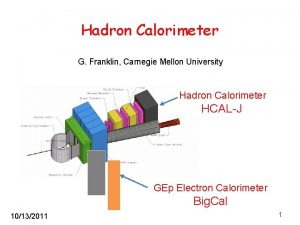A few commissioning experiences from a few hadron



















- Slides: 19

A few commissioning experiences from a few hadron facilities (SNS, RHIC, AGS Booster, LANL PSR) Thomas Shea ESS T. Shea, 2015 -11 -07

Outline • Testing and commissioning overview – SNS v. ESS • Stories and Lessons, organized loosely by theme – – – Integration Protection Verification Concurrent Development Human performance • End game and Organization T. Shea, 2015 -11 -07

Vertical Testing to interfaces then Horizontal Testing across interfaces Machine Protection Interfaces: Accelerator Interfaces: Controls network Buffering Timing/event RF reference Low-latency data Signal Processing post mortem device health configuration beam interlock component state Shielding cabling Beamline device T. Shea, 2015 -11 -07 Also: • Power • Alignment • Cooling • EMI • Radiation

SNS commissioning ran in parallel with installation and testing 1 2 2002 3 4 2003 5 6 2004 7 2005 8 9 2006 Run #1: - RFQ at LBNL (2. 5 Me. V), Jan 25 th through Feb 2002 - beam stop for design beam power Run #2: - Front End at LBNL (2. 5 Me. V), Apr 4 to May 31, 2002 - beam stop for design beam power Run #3: - Front End at ORNL (2. 5 Me. V), Nov 5, 2002 to Jan 31, 2003 - beam stop for design beam power Run #4: - Front End, DTL tank 1, D-Plate (7. 5 Me. V), Aug 26 to Nov 17, 2003 - beam stop and radiation shield for design beam power Run #5: - Front End & DTL tank 1, 2, 3 (39 Me. V) Spring 2004 - Beam stop and radiation shield for reduced beam power (50 us, 1 Hz) Run #6 : - Front End, DTL, CCL modules 1, 2, 3 (158 Me. V) Fall 2004 - Beam stop and radiation shield for reduced beam power (50 us, 1 Hz) Run #7 : - Front End, DTL, CCL, SCL (1 Ge. V), Aug 2005 Run #8 : - Front End, DTL, CCL, SCL, Ring (1 Ge. V), Feb 2006 Run #9 : - Front End, DTL, CCL , SCL, Ring, Target (1 Ge. V), April 28, 2006 4 T. Shea, 2015 -11 -07

Awake at Night Comparison RFQ/MEBT/DTL 1 Source/LEBT at Catania Source/ LEBT ESS 2002 1 2 MEBT In the past, ESS appeared too compressed. Now, I think that it looks achievable and similar to RHIC and SNS. T. Shea, 2015 -11 -07 DTL 2 -4 2018 2017 SNS To target DTL 5 + Spokes + Medium Beta 2019 2020 2003 3 improve 4 DTL 1 2004 5 2021 2005 6 improve Deployment at scale: superconducting linac devices 7 Elliptical 2022 2006 8 9

Story time! T. Shea, 2015 -11 -07

Integration: SNS @LBNL Beam Physics and Systems meet at the Application Layer “ 99% complete is 100% failure” * the orbit app worked live from ORNL simply initialize with the Process Variable names EPICS screen app Chann Network Attached Devices: 1 week to integrate all MEBT diagnostics at LBNL (from 4 labs) with timing and EPICS screens el Acc ess Cables & install - LBNL Electrodes - LBNL T. Shea, 2015 -11 -07 * W. Blokland, 2001 Electronics, NAD software - LANL

Integration Lessons re: Controls • Use of EPICS allowed modular deployment with a mature (but quite simple) control system toolkit – Installation and vertical integration of network-attached devices performed rapidly and independently – Minimal coordination needed (just check in at daily standup meeting) • Compared to RHIC – RHIC commissioned the controls toolkit with the systems – painful! – But RHIC controls started with some useful features that SNS lacked: triggered, continuous data acquisition; post-mortem; service-layer to manage device collections • Both: – Built-in self test was very valuable – Early availability of final timing and MPS systems was critical T. Shea, 2015 -11 -07

Integration Challenges: Electromagnetic Interference @ SNS c. 2004, In order of decreasing impact. Efforts focused on BCM and Loss systems System Signal level Frequency Range Comments on Noise BCM Tens of m. V into 50 ohms Must heavily filter waveform and baseline subtract to reduce noise to few percent. Loss Hundreds of < 35 k. Hz p. A Few Hz to hundreds of MHz Noise on fast channel = 30% beam loss. Slow channel OK. Faraday Hundreds of DC – few MHz Cup/ m. V Beam Stops Same issues as BCM low frequency range, but stronger signal. Wire Scanners micro. Amps < 40 k. Hz Noisy waveforms, but requirements exceeded by analysis and averaging BPM Ten m. V into 50 ohms Few MHz around RF Near 402. 5 MHz RF systems, (402. 5 and 805 MHz) measure 805 MHz, and vise versa T. Shea, 2015 -11 -07

Protection: Commission with safe “probe” pulses • Specify performance with low current, short pulse (“safe”) beam such that beam can be lost most anywhere without causing damage • Bonus: Allows tuning RF without impact of beam loading • ESS probe beam will be critical for MPS commissioning 1990 BNL Linac to Booster position electronics (analog processing at twice RF frequency) 200 ns pulse T. Shea, 2015 -11 -07 • RHIC sextant, first turn: Orders of magnitude below nominal • Self triggering very helpful SNS vector receiver < 1 µs

Verification with beam: Difference Orbits in RHIC • Quickly verify optics and BPMs • Difference orbit: App uses online model, live and saved BPM readbacks, kick strength is free parameter, … • Recommendation: System owners lead system commissioning with beam, supported by machine commissioning/ops team. Then handoff. • SNS verified with beam in 7 sections • RHIC rings verified with beam in virtually one go T. Shea, 2015 -11 -07 11

Concurrent Development: SNS BPM Position/Phase Measurement “We know that BPMs in proton linacs don’t work”* • • • Worked even embedded within DTL Measure harmonic away from RF (like @BNL Linac to Booster line) Vector receivers (I-Q at SNS): retain phase Results: • Scrap dedicated phase monitors • Didn’t really need measurements with energy degrader-faraday cups for DTL tuning • Diagnostics engineers helped design LLRF • With automated tuning apps, 8 hours reduced to ~30 min T. Shea, 2015 -11 -07 * R. Siemann, 2000 1. 8 deg. at Berkeley, 2002 0. 1 deg. at ORNL, 2 years later

Concurrent Development: Old School • Formal procedures are necessary, but should support some use cases from the “good old days” • Allow agility where appropriate • Good asset management can help LANL (1980 s), AGS Booster (1990) • Very limited data/document management RHIC/SNS (1990 s/2000 s) Better: • Global database (required for deployment at scale), • Primitive document management • Inconsistently applied ESS risks a step backward with lack of data-driven approach; heavy, documentdriven configuration management T. Shea, 2015 -11 -07 There, I fixed it. Phase measurement system in a week … at LANL in the 1980 s

Human Performance • Configuration errors – Mitigate with thorough verification before beam • Shortcuts under pressure – Noise filters on SNS machine protect inputs: now a suspected contributor to SC cavity degradation -> fixed this and also deployed differential BCM • Commission early and often, but not too often – Usually enough staff to install and integrate systems, then support operations phase – 24 by 7 commissioning can add too much peak load -> burnout T. Shea, 2015 -11 -07 RHIC commissioning, Aug 16, 1999 Owl shift summary loglook entry: “…BPM reading in general were difficult to interpret since some BPMS read data from other BPMs/plans/rings. We corrected the large orbit deviation at yo 9 bv 1… No progress, however, at the main Losses…”

End Game: Integrated Accelerator, Target and Neutron Instruments T. Shea, 2015 -11 -07

Some considerations for ESS compared to short pulse sources • Rotating target (but controls are simpler than existing chopper controls) • Long Pulse source couples machine and neutron instruments • Pulse by pulse modulation requires full timing system functionality Two dominant causes of neutron intensity fluctuation 1. Ion Source and RFQ produces proton pulses with some current fluctuation Low loss (< 1%) acceleration and transport Low energy variation (+/-1. 5 %) allowed 2. Raster System scans proton beam across target; moderator coupling is position dependent Accelerator and Beam Transport 16 T. Shea, 2015 -11 -07

Early Operations and Performance Ramp • RHIC highest priority: gradual accumulation of integrated luminosity • SNS chose to ramp power rapidly rather than staying conservative. Shook out issues during a period when lower availability was tolerated. Only a few years of this will be tolerated by user community: work fast! • Functionality: The minimum for commissioning may not be enough for this phase and there is limited time for new development. – First proton functionality – Roadmap to full functionality, back by design work during construction phase T. Shea, 2015 -11 -07

Organization • SNS had area managers, RHIC did not (topical management). Both ways worked for commissioning • All: Daily standup very important to coordinate physical work • RHIC and SNS: Weekly meeting with machine director and work package managers – Line aligned with project – Rapid decisions • Managing the end game – SNS rolled partners off too early. Partner engagement through commissioning aligns motivation with project goals – Instruments saw no need to share data with control room. User engagement may soften transition to operations • Recognize that the organization is being commissioned T. Shea, 2015 -11 -07

thanks Particular thanks to many Beam Diagnostics and Beam Physics colleagues at BNL, LANL, LBNL, and ORNL. Input from: M. Plum, J. Galambos, A. Aleksandrov, W. Blokland, A Shishlo, A. Zhukov, T. Satogata, S. Assadi, J. Staples, A. Ratti, J. Power, A. Jason, D. Purcell, C. Deibele, T. Mc. Manamy, C. Goetz, R. Witkover T. Shea, 2015 -11 -07
 Adverb little
Adverb little Hadrons
Hadrons Hadron calorimeter
Hadron calorimeter Hadron
Hadron Hadron collider
Hadron collider Hadron collider
Hadron collider Fill in a little or a few
Fill in a little or a few Complete these words
Complete these words A few vai few
A few vai few Jwst commissioning timeline
Jwst commissioning timeline Value based commissioning
Value based commissioning Ecs commissioning
Ecs commissioning Dominik sikora
Dominik sikora Commissioning cycle
Commissioning cycle Pod point commissioning
Pod point commissioning Vacuum systems commissioning
Vacuum systems commissioning Dr nicola burbidge
Dr nicola burbidge Ecs commissioning
Ecs commissioning Hmsweb
Hmsweb Integrated commissioning and progress system
Integrated commissioning and progress system


